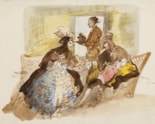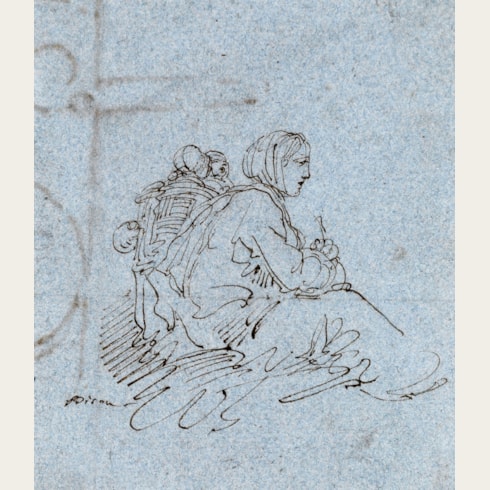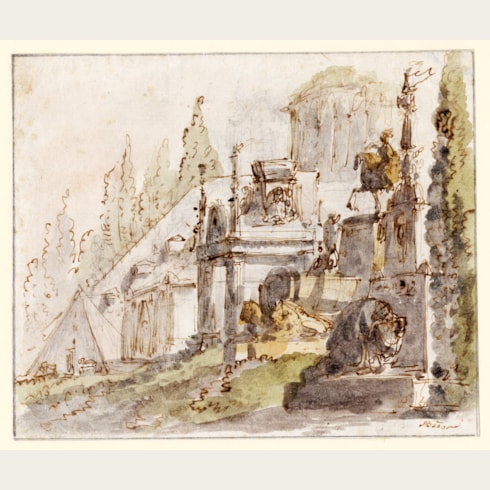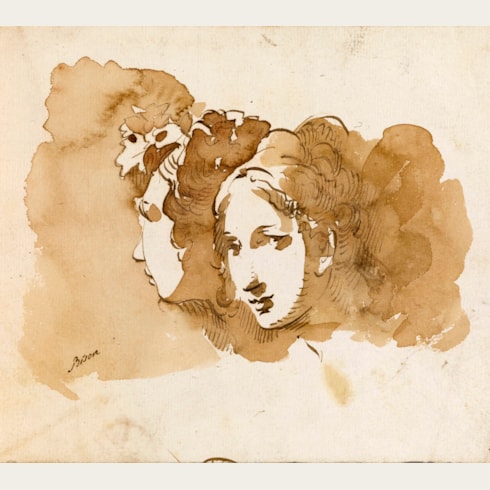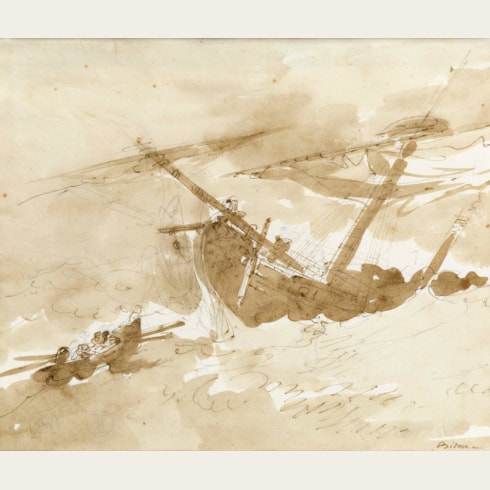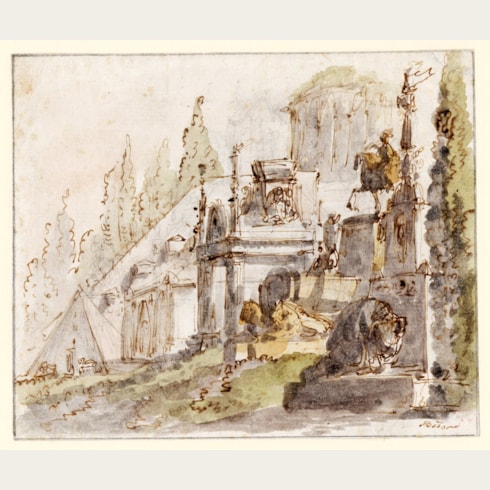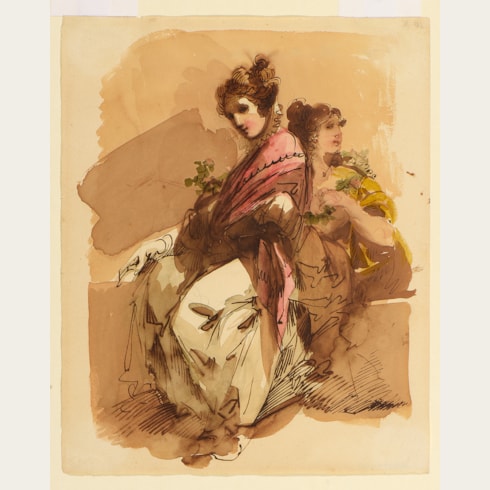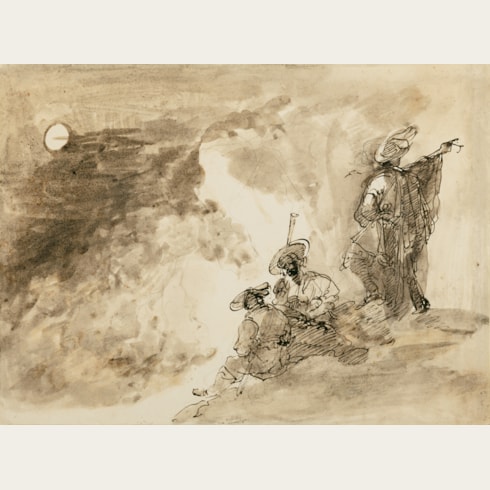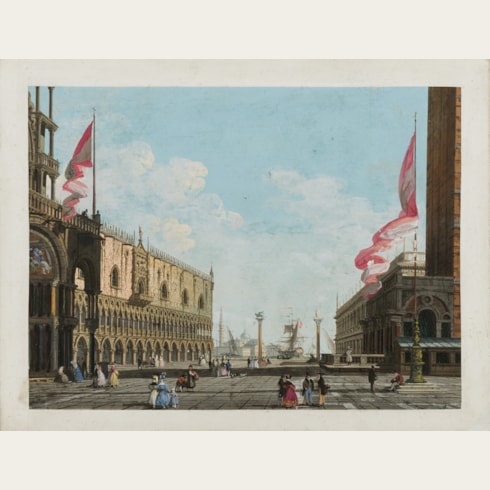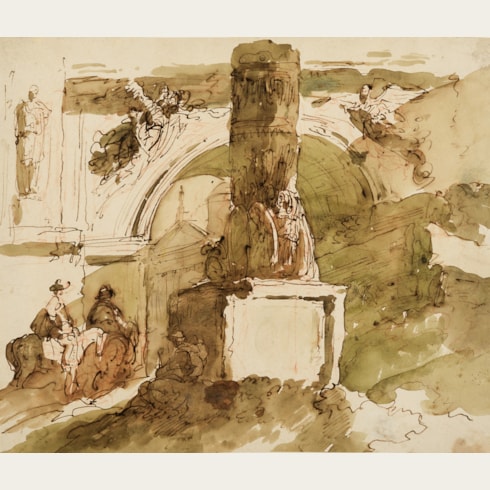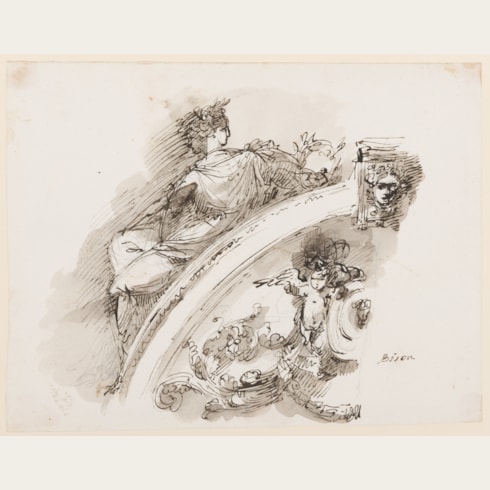Giuseppe Bernardino BISON
(Palmanova 1762 - Milan 1844)
An Elegant, Masked Couple Drinking Coffee
The sheet cut out in the middle, between the two seated figures, and the figure of the servant drawn on a separate piece of paper and inserted into the composition.
186 x 234 mm. (7 3/8 x 9 1/4 in.)
The drawing provides an interesting insight into Bison’s working methods, since the figure of the servant has been drawn on a separate sheet of paper and carefully inserted into the composition. This was a practice occasionally adopted by the artist when he wished to make changes to the compositions of his finished, independent drawings; another such example is a genre watercolour of A Peasant Family Loading a Donkey, also from the Baroni collection, which appeared at auction in 1995 and 2017.
This fine watercolour by Bison was at one time in the remarkable collection assembled by the Anglo-Austrian art historian and collector Count Antoine Seilern (1901-1978), who purchased it from Colnaghi’s in 1951. Seilern studied art history in Vienna and began buying paintings and drawings in the 1930s, eventually amassing a superb collection, which included drawings by Fra Bartolommeo, Pieter Bruegel, Stefano Della Bella, Francesco Guardi, Michelangelo, Parmigianino, Rembrandt, Rubens, Giambattista and Domenico Tiepolo and many more. At his death, the bulk of Seilern’s collection was bequeathed anonymously, as the ‘Princes Gate Bequest’, to the Courtauld Gallery in London. Although Count Seilern owned at least three other drawings by Bison, the present sheet does not appear in his privately-printed catalogue of the Italian paintings and drawings in his collection, first published in 1959, and may have been out of his possession by that time.
In the early 1800s Bison settled in Trieste, where among his most important works were the decoration of the Palazzo Carciotti with scenes from the Iliad, painted in monochromatic tempera between 1803 and 1804, and the ceiling of the Palazzo della Borsa Vecchia, completed in 1805. He also produced set designs and decorations, now lost, for theatres at Vipacco and Gorizia. In 1831, at the age of sixty-nine, Bison moved to Milan, where he was active for the remainder of his career. There he was particularly active as a scenographer, painting stage designs for the Teatro alla Scala and other theatres. Although his career lasted well into the 19th century, his style continued to retain something of the flavour of the Settecento. In 1842 an exhibition of around a hundred of Bison’s works was held in Rome. The artist died two years later, in relative penury despite his earlier successes.
Bison was an accomplished and prolific draughtsman, with an oeuvre of charming genre studies and landscapes in pen and ink wash or gouache. His earliest works show the influence of Giambattista Tiepolo and Francesco Guardi, while his later drawings tend towards Neoclassicism. His drawings encompass a wide and varied range of subjects, from religious narratives to genre scenes, capricci, and stage and ornament designs. Few of Bison’s many drawings, however, were done as preparatory studies for paintings, and he seems to have produced a large number of his drawings as independent works of art for sale; this is certainly true of his pastoral landscapes in gouache. Significant groups of drawings by Bison are today in the collections of the Castello Sforzesco in Milan, the Musei Civici in Trieste and the Cooper-Hewitt Museum in New York.
Provenance
Bought from him for £4 by P. & D. Colnaghi, London
Purchased from them for £14.14s in May 1951 by Count Antoine Seilern, London
Private collection, England
Anonymous sale, London, Phillips, 4 December 1989, lot 74
W. M. Brady and Co., New York, in 1990
Ambassador and Mrs. Felix Rohatyn, New York
Thence by descent.
Exhibition


